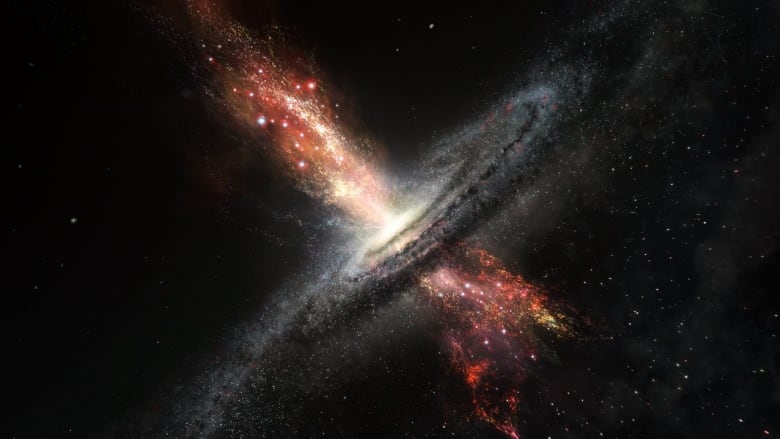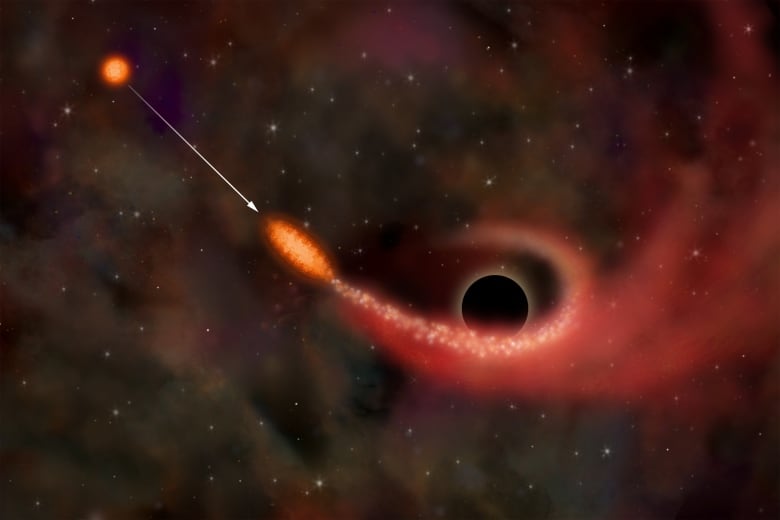Supermassive black holes give birth to stars, astronomers discover
These stellar gourmands gobble up stars but also form them from rapid outflows of gases

A team of astrophysicistshas discovered that supermassive black holes at the centre of galaxies aren't just destroyers of stars, but can also be their creators.
Stellar black holesform from the collapse of a large star. They can have a massof 20 times that of of our sun or higher, and they consume anything that gets too close,including a star.
There's another category of these stellar gourmands: supermassive black holes.These have masses more than one billion times that of the sun andlurk at the centre of most galaxies, including our own.
While it was suspected that these supermassive black holes could actually be giving rise to new stars while simultaneously destroying unfortunate interlopers, there wasn't enough direct evidence to support that theory. Until now.
Recently, ateam of European astronomerswasobserving the collision of two galaxies some 600 million light-years away each with a supermassive black hole at its centre using the Very Large Telescope (VLT)in Chile. There, they found evidence of new star birth frommaterial being ejected from the black hole, called an outflow.
While it might seem a contradiction that nothing can escape a black hole, butan outflow of gas is responsible for creating new stars, it's all about the location:nothing can escape a black holeonce it gets so close thatall matter is sucked in and can't escape.
However, the gases that swirl around the centre of the black hole think of water going downa drain exist in something called an accretion disc.
It's from there that gases are heated to incredible temperatures and then are rapidly ejected into space. Astronomers believe that some of the material might be flung out of the galaxy altogether.

The stars that have beencreated lie a good distance from the supermassive black hole, some about 100 light-years away, while others considerably farther, perhaps 5,000 to 10,000 light years away,
Some of these stars might eventually fall back into the supermassive black hole in atype of recycling,while others may end up on the far edges of the galaxy's spiral arms, or evenout of it.
The newly discoveredstars are much larger than our own sun: about 10 times its mass, said RobertoMaiolino, an astrophysicist and lead author of the paper that was published Monday in the journal Nature.
They could even be 40 or 50 times as large as our sun. In terms of a universal time scale, they are considered infants, believed to be less than a few tens of millions years old.
Changing the theories
The discovery isexciting for astronomers and could reshape the theory on galactic formation.
While spiral galaxies have a bulge of stars at their centre and a diffuse cloud of stars called a halo, elliptical galaxies are mostly spheroidal. If stars are formed by this type of outflow, however, it could explain the shape of galaxies.
"If this is common, as some models predicted ... this could change quite drastically our understanding of galaxy formation evolution," Maiolino told CBC News. "It is a completely new mode of forming stars in galaxies."
- Universe may contain 10 times as many galaxies asbelieved
- Supermassive black hole spotted devouring surprising meal
As well, this could help explain how heavy elements have come to exist in the space between galaxies, called the interstellar medium.
Maiolino said the team has begun searching more galactic cores for more cases of this type of stellar formation.
"The next step is to understand whether this is a peculiar system in which this phenomenon is taking place or it is common," he said.
Though studying galactic cores is a difficult task, he said he hopes that, with the launch of the James Webb Space Telescope in 2018, more research can be done.












_(720p).jpg)


 OFFICIAL HD MUSIC VIDEO.jpg)
.jpg)



























































































